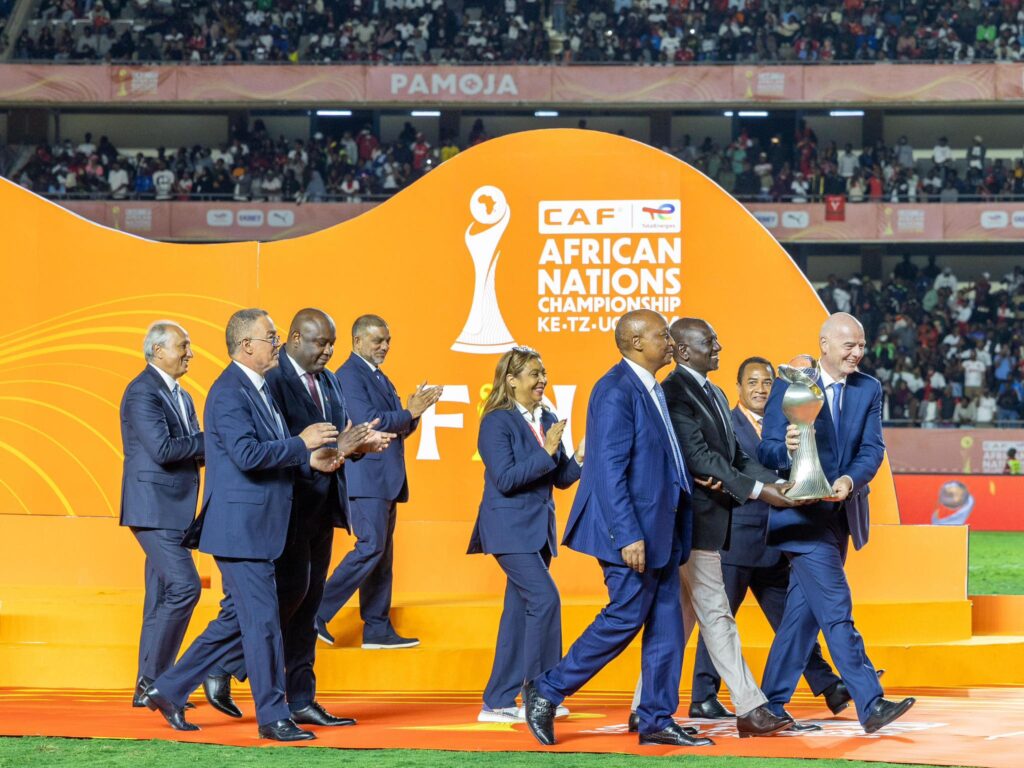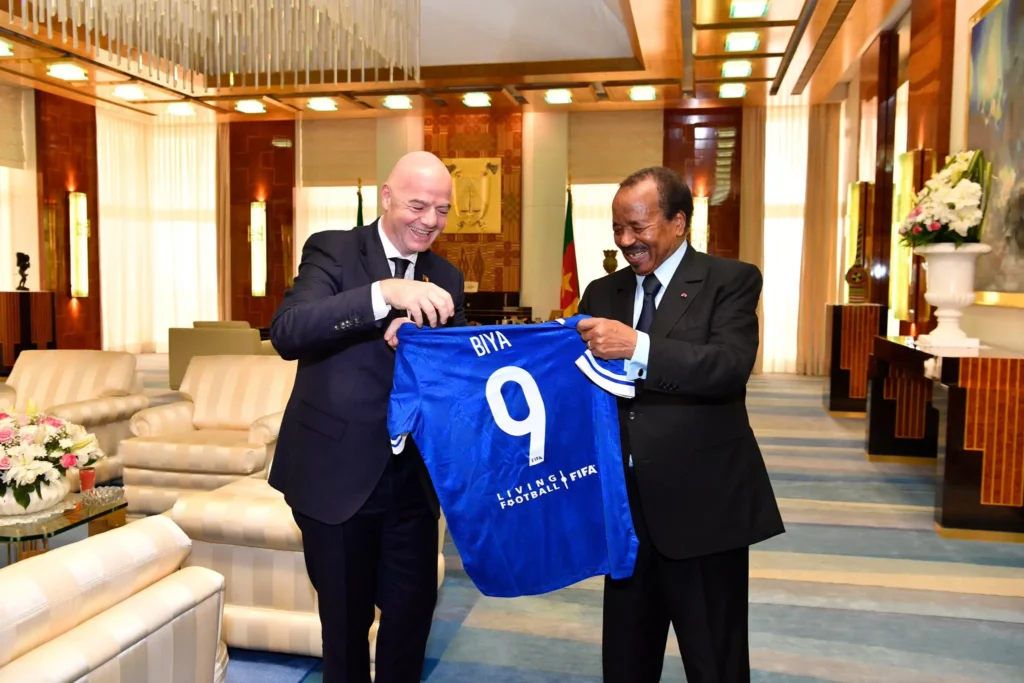Recently, East Africa has been abuzz with kerfuffles, drama and brouhaha that come with hosting an international football tournament in Africa. From presidential decrees of hefty player bonuses, ticketing conundrums blamed on reasons ranging from state suppression of dissent to tech mishaps, all that seemed like omnishambles was in fact a feature of the governance of African football. And the CHAN tournament is an indictment of how neglected and deeply politicised African football has become.

President William Ruto walks alongside a delegation of football officials, including CAF President Patrice Motsepe and FIFA President Gianni Infantino, during the trophy presentation ceremony at CHAN. Image source: State House Kenya (Facebook)
The African Nations Championship (CHAN) is a tournament reserved for players who are active in their own domestic leagues. It was first floated as an idea in 2007 and the first edition was played in 2009. It was created to stimulate investment in national leagues and slow the talent drain to overseas clubs.
HOW DID WE GET HERE
Africa’s football talent pool has long been essential for world football even before the formation of CAF, with players such as Morocco-born Larbi Ben Barek representing France in the 1940s and Portuguese clubs systematically recruiting talent from their African territories. This early pattern established the continent as a supplier of football talent for consumption in European markets, a dynamic that intensified after independence as French, Belgian, and Portuguese clubs continued to draw on colonial networks to source players. However, the scale of this migration was constrained by European quota systems and work permit requirements that limited the number of non-EU players clubs could sign.
In 1995, club eligibility rules were altered by the European Court of Justice at the Bosman ruling, scrapping transfer fees for out-of-contract EU players and outlawed EU-nationality quotas. Essentially, this meant that football clubs could no longer charge fees when a player’s contract expired and wanted to move to another team within the EU, and teams were prohibited from limiting how many EU players they could field hence changing how players moved between clubs and how teams were assembled.
Following that in 2000, the Cotonou Agreement—signed between the EU and 78 African, Caribbean and Pacific (ACP) countries with a clear non-discrimination clause for employed workers—and the Kolpak judgment in 2003 which held that athletes from any state with an EU association accord enjoy the same freedom to work as EU citizens, extended Bosman’s logic to players from the ACP bloc.
This meant that from the mid-2000s onward most EU leagues had to treat many ACP footballers as if they were EU citizens for roster-quota purposes. Although some leagues (e.g., Spain, Italy) kept tight non-EU quotas, the combined legal easing and surging TV revenues triggered a talent exodus, hollowing out many African leagues and reshaping the competitive ecology of world football.
Because of this brawn drain, CAF’s flagship tournament, The Africa Cup of Nations (AFCON), gradually became a stage for mostly European based stars outcompeting the local based players on national team caps. Hence why CHAN was launched as a corrective stage exclusively for players plying their trade in their country’s leagues.
Four months after CHAN was launched, an Algerian-led motion at the FIFA congress successfully challenged the age-21 limit on changing national teams, lifting a barrier that had constrained dual-national footballers everywhere including, but not limited to, many Europe-born players of African descent.
A decade later in 2020, Morocco led a second, deeper reform that let one-cap wonders represent another nation if they did not have no more than three competitive appearances before turning 21. In other words, players who had only appeared once for a national team, or played a maximum of three times before age 21, could now switch to represent a different country, effectively opening the door for athletes with dual citizenship or heritage ties to change their international allegiance.
The effect of this is that African national team squads for tournaments and competitions other than CHAN (such as World Cup qualifiers) are increasingly composed of foreign-born players. At the 2018 FIFA World Cup, 34% of the players representing African nations were born outside the continent. By 2022, that figure rose to 42%. In the 2021 AFCON edition, 27.5% of the players were foreign-born, a number that rose to 31.8% in the 2023 edition. Of the 603 players in the recent edition, 200 were foreign born with the majority of them (104) born in France, a trend which is paradoxical to the statistics projecting Africa as the world’s labour force due to its demographic boom.
In both instances of CAF’s lobbying for national team eligibility reform, their votes were enough to alter FIFA’s rule book, a muscle that would have been better flexed to protect the hemorrhage of players from Africa’s member associations or to capitalize on the transfer of players. Contrast this with UEFA’s deployment of the legal autonomy, conferred by FIFA’s article 22, to create the homegrown player rule, which protected the interests of European clubs and domestic talent.
South America for its part, rewired the economics of export ensuring that youth academies and clubs that had developed a player during their formative years would still receive financial compensation—a percentage of any future transfer fee—even after the player moved to a different club, ensuring that the institutions that invested in training young talent were rewarded for their development work.
In the 2016-2022 report of the FIFA Forward Development Funds, African FAs were the largest recipients, receiving USD 518 million in total. Out of this, USD 118.7 million went solely to infrastructure with FIFA claiming that 94 new pitches were laid out. Alongside funds for national teams and competitions, FAs also received funds for capacity development in education and training for coaches and referees. Despite receiving such amounts of money, African FAs are systematically failing at their most basic mandate of developing domestic football.
The operating costs that FIFA Funds are supposed to underwrite are routinely offloaded by the state or invoiced to the very parties that it is meant to subsidize. For example, in Zambia—where the median living wage is 121 USD per month—the football association charges 215 USD for a CAF C license which is viable only in grassroots, youth and amateur sides anywhere within CAF’s 54 member countries. At most, this license allows a coach to sit on the bench as an assistant in continental club competitions but it is not enough to head-coach a top-flight or national-team squad, nor does it carry weight outside Africa because the European, Asian and Americas confederations do not recognise any CAF licenses.
In Ghana, the once-proud Premier League now averages fewer than 800 spectators a match, down from five-figure crowds two decades ago with marquee clubs Asante Kotoko and Hearts of Oak forced into ad-hoc salary settlements and debt restructurings just to keep the lights on. Federation officials routinely plead poverty for domestic operations, yet the same federations still budget for large delegations to FIFA and CAF junkets.
In most instances African government or persons with political interests pick up the tab for leagues, clubs or local tournaments. For example, the Cameroonian federation appealed to the presidency and secured 560 million CFA francs (around USD 900,000) to bail out elite clubs. Five hours flight south, Equatorial Guinea’s twenty‑four‑team top flight leans almost entirely on national treasury cheques where the government funds indirectly in the state‑owned enterprises “sponsorships” for the league and the clubs.
Furthermore, after President Patrice Motsepe’s 2021 stadium ban left 20 national teams homeless, states were left to fund stadium infrastructure, often sourced through opaque Chinese contracts, or else pay to stage “home” qualifiers in Morocco or South Africa at significant extra cost (e.g., Kenya’s KSh 21 million/USD162,000 for a single fixture).
The same states foot the bill for continental tournaments as CAF is the only confederation in world football that demands bidding and hosting fees. Because stadium construction contracts usually externalise design, labour, and materials, governments shoulder both the debt and the long-term maintenance burden, while CAF’s inspectors police compliance, shutting non-conforming venues and suspending countries like Ghana and Mozambique until upgrades meet its checklist.
In this system, the confederation administers the stick while the state picks up the bill, underwriting stadium projects that rarely generate sustainable revenue and frequently divert resources from essential sectors such as health or education.

The very scarcity of public investment in social services is what makes stadium construction politically attractive as stadiums offer visible symbols of progress that governments can point to, even as classrooms and hospitals remain neglected. As such for states that lack strong public services, institutional trust, or procedural fairness and whose precarious legitimacy is exacerbated due to corruption and neglect of these sectors, football becomes one of the few remaining arenas where state legitimacy can be performed and momentarily secured.
This is why for the East African CHAN edition, all three presidents presiding over the host nations declared hefty bonuses to players should they win a match, and why the Ugandan parliament demanded that a budget for publicizing the tournament be ring fenced . Whether it’s a coincidence or a calculated alignment that these states are thick in their election cycles (Tanzania 2025; Uganda 2026; Kenya 2027) during CHAN and in the lead up to AFCON 2027– which they will jointly host again– is for the jury to decide.
WHERE THE GAME STANDS
The net effect is that African footballers, clubs and leagues are trapped in a cycle of exploitation and neglect, surviving if and when they are politically useful. In such an eco system, it is no wonder that the football leagues in the continent struggle to keep their best prospects or produce good enough players who can compete in AFCON or the World Cup.
In designing CHAN, CAF is admitting that the domestic leagues are weak, player development so poor, and the talent retention so abysmal that there is need for a separate competition where local players don’t have to compete with foreign-based and born ones. CHAN is a confession of failure at best and at worst, an illusion that masks CAF’s indifference to actually fixing the structural rot within its jurisdiction.
There is little incentive, if any, for all actors involved in African football, to self correct because the system distributes just enough legitimacy, revenue, and optics to its core actors — CAF, FIFA, governments, and federations — that none of them have reason to change. Furthermore, much of this is enabled due to the monopolistic nature of football business where federations are the only parties claiming stake to athletes, referees, and corporate sponsorships. Nonetheless this monopolistic stake on football is being challenged in other regions of the world, for example, with Gerrard Pique’s King’s League and Lagos Liga emerging in Nigeria. As such, African stakeholders such as former players or investors ought not shy away from bypassing federations to create such franchise leagues. The failing ecosystem in Africa will only self correct if and when its shell—the sponsorship and corporate deals— is exposed and the roots is cut off (the athletes, coaches, fans).
These franchise leagues can and may only be successful in countries where the state’s reach is not an existential risk for its citizens because member associations, conspiring with the state’s apparatus, may impede such developments. Even so, the very demand to utilize the costly stadiums may, paradoxically, exert pressure on governments to seek tenants beyond their often complicit football associations. As such, the independent leagues may find themselves presented with opportunities to utilize state-owned stadiums, potentially offering mutual benefit by giving states a means to justify their boondoggles while providing better facilities for the private leagues. Yet, this path must be navigated with extreme caution.
Leave a Reply